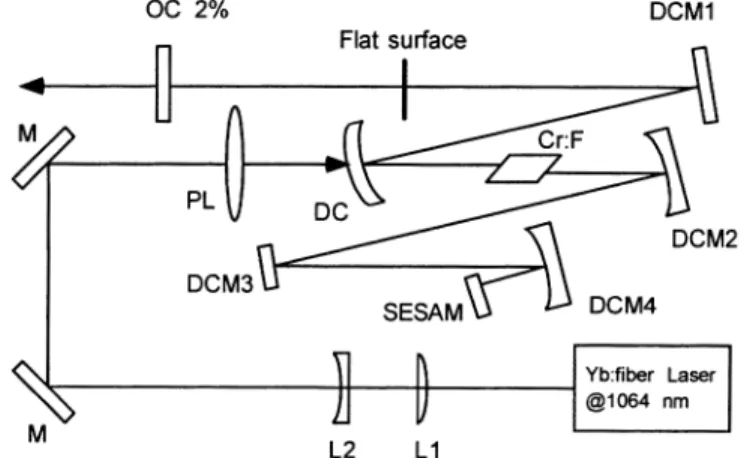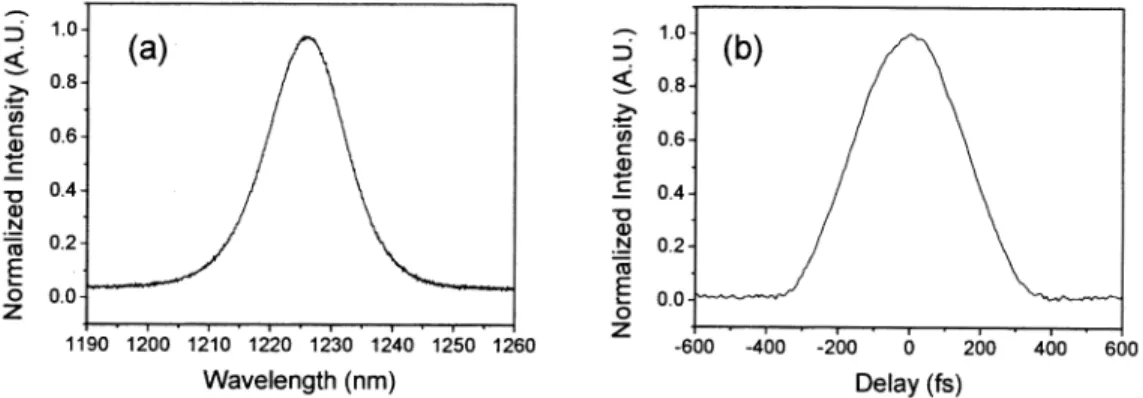CThN7
2005 Conference on Lasers &Electro-Optics (CLEO)Multiplying
the
Repetition
Rate of Passive
Mode-locked
Femtosecond Lasers
by
an
Intracavity
Flat
Surface with
Low
Reflectivity
Tzu-Ming Liu andChi-KuangSun
Graduate InstituteofElectro-Optical EngineeringandDepartmentofElectricalEngineering,National TaiwanUniversity, Taipei 10617, TAIWAN
PhoneLl886-2-23659703,FAX,Y886-2-23677467,E-mailE1J8941002@,ee.ntu.edu.tv FranzX.KartnerandJames G.Fujimoto
DepartmentofElectricalEngineeringandComputerScienceand ResearchLaboratory ofElectronics, Massachusetts InstituteofTechnology, Cambridge,Massachusetts 02139
Abstract: We demonstrate aflexible andphaseinsensitive methodto multiplytherepetition-rate ofpassive mode-locked solid-state lasers in femtosecond regime. It wasachieved by inserting a
low-reflectivityflatsurface inside the oscillatorcavity.
©2005Optical Societyof America
OCIS codes:(140.3070) Infrared and far-infraredlasers, (320.7160) Ultrafast technology.
High repetition-rate (HRRR) femtosecond lasers enable a wide range ofnewapplications in optical communication [1], and frequency metrology [2].Forspectroscopy andsensing applications,HRRlasers reduce thepeakintensities whilemaintaining a high average power, which is important for achieving high signal-to-noise ratios. In order to increase therepetitionrate, thesimplestwayistoshortenthecavity length. Considering highpowerandshort
pulse-width,
passivemode-locked all solid-state lasers withacompactcavityisapopular choice[3,4].
Butonce aHRR mode-locked laser isbuilt, the repetitionrate cannotbe easilymultiplied
withoutchangingthe cavity design. For passive mode-locked lasers, repetition-rate multiplication with a coupledextemal cavity is amore convenient andcosteffective solution [5]. However,previouslydemonstrated methodsrequirephase-sensitivemodematchingtoan
external coupled cavity and allprevious studiesonly operated in the nanosecond orpicosecond regimes [5-8]. In thisletter, wedemonstraterepetition-ratemultiplication by usinganintracavityflatsurface with lowreflectivity in a passively modelocked Cr:forsterite laser. Incontrast to all previous studies [5-8], ourintracavity low-reflectivity flat surface acts as apulse seeder rather than a couplerto amatched external resonant cavity. By controlling the ratio of the subcavity length, repetition-rate can thus be successfully multiplied in the femtosecond regime in a flexible andphaseinsensitive way.
OC 2% DCM1 Flatsurface SESAM DCM4 Yb:fiber Laser \ @1064 nm L2 Li
Fig. 1. Schematic diagram of the highrepetition-rate femtosecond Cr:fosterite laser. M: folding mirror; L1, L2: mode-matching lenses; PL: pump lens; DC: dichroic curve mirror (R=10 cm);
DCM1,
DCM3: flatdouble chirped mirrors; DCM2, DCM4: curved double chirped mirrors (R=10 cm); SESAM: semiconductor saturableabsorbermirror; OC: output coupler; Cr:F: Cr:forsterite crystal.CThN7 2005Conference on Lasers & Electro-Optics (CLEO)
Consider a linear cavity withan optical-path length 1,the pulserepetitionrate
Ro
is equalto c/21, where c is the speed oflight. By inserting a flat surface with low reflectivity, the optical cavity can be partitioned into two subcavities with lengths 1 and12(II<
12). When11/12=N/M
isarational number(N
and Marepositive
integers
with nocommondenominators), for eachsplitofapulse,thereflectedone lagseitherN/[(M+N)R0]
orM/[(M+N)RO]
intimeto thetransmittedone. With this property, the time interval between anysplit
intracavity
pulseandthe initialsingle pulse can be expressed as
K/[(M+N)RO],
where K is an integer from 0 to M+N-1. The final number ofintracavity pulses isM+Nand therepetition-rateR canbemultipliedto
(M+N)Ro.
Thismeansthat foragivenmainlaser cavity,we canmultiplytherepetitionratebysettinganappropriateratioof thesubcavitylengths.
The laser we employed to demonstrate this approach is a femtosecond Cr:forsterite laser (Fig. 1). Its cavity is
composed of one dichroic curved mirror (DC), two curved
double-chirped
mirrors (DCM2, DCM4), two plane double-chirped mirrors (DCM1 and DCM3), a semiconductor saturable absorber mirror (SESAM), a 2% output coupler, and a Cr:forsterite crystal. Except for the SESAM and the outputcoupler,
all mirrors have high transmission at the pump wavelength (1064 nm) with broadband high reflectioncoating
around the lasing wavelength. We usea standard z-fold cavitydesign
forastigmatism compensation.
The radius-of-curvature of the focusing mirrors are all 10-cm. The Cr:forsterite crystal is a Smmx5mm x11.4mm Brewster-cut crystal with anabsorption coefficient of 1.5
cm-'.
The crystal was cooled by liquid and a TE cooler. To prevent watercondensationonthe surface ofthecrystal, itwaspurgedwithdrynitrogen. The SESAM withapicosecondtransient response is for self-starting and enhancement of the
mode-locking
force [9]. The double-pass group-delay-dispersion (GDD) arose from the lasercrystal is 568 fS2 around 1230 nm [10]. Weemploy double-chirped mirrors (DCMs) instead of prism pairs to compensate the crystal GDD [11]. Each DCM provides -150fs2
GDD around 1230 nm. To make soliton-like pulses operate in the stable regime, the net cavity dispersion should be slightly negative[12]. Howeverforamode-lockedcavity withaSESAM, toomuchintracavity energy will result in doubleormultiple-pulse operation, whichset anupper limit forthe output power[13]. Toincrease the upperlimit, the net GDDshouldbemorenegative. Therefore,weemploy4DCMs(DCM1-4)forhigher availablepower,which results in -632 fS2netGDDwithinoneroundtrip. The pump sourceisanYb:fiberlaseroperating at 1064 nm.After a lens pair
(Li
andL2) andapumplenswitha 10-cm focaldistance,pumpbeamwasfocusedinto the crystal with -30jrm beamradius atthe focus. Usinga self-consistent q-parameter analysis, the radius of beam waist inside the crystalwasapproximately 28
ltm,
closetothat of the pump beamatthesameposition. With 1°Ccrystaltemperature and7-Wpump power,we canobtain 40-mW average output powerata 124-MHzrepetition-ratewithoutmultiple pulsing [13]. Without insertingthe flat surface, the output spectrumshowed
11-nm
bandwidth at 1225 nm (Fig. 2(a)). The background freesecond-harmonic-generation
autocorrelationtracemeasured253-fs FWHM (Fig. 2(b)), indicating-164-fspulse width assumingasech2pulseshape.
10 (a)
10(b)
0.8 0.8(D0C
C:~~~~~~~~~~~ -~0.4 .S 0.4 N ( 0.2- N 0.2-_E__ _0 z 1190 1200 1210 1220 1230 1240 1250 1260 -600 -400 -200 0 200 400 600 Wavelength (nm) Delay (fs)Fig. 2. The spectrum (a) and the autocorrelation trace (b) of the 124-MHz Cr:forsterite laser without inserting a low-reflectivity flat surfaceinside thecavity.
Wefirst placeda flat surface into thepoint where
11=115,
trying to multiply the repetition rate up five-fold. The employed intracavity flat surface is a BK7 glass with150-pm
thickness. In order to reduce bandwidth limitation from etaloneffects, one side of the glass is anti-reflection coated for high transmission (transmission T>99.8%). The other uncoated surface provides -4% reflection, serving as the intracavity flat surface. The glass was fixed on a mirrormountandatranslation stage with a1-gm
resolution. After inserting the glass, without any carefulalignment, the repetitionratedidnotmultiply. Inaddition, under 8.4-Wpump power, the output spectrum showed a narrowedCThN7 2005 ConferenceonLasers&
Electro-Optics
(CLEO)
bandwidth
(-0.3
nm)
and theoutputpowerwas80 mW. Aftermaking theglass normal totheintracavity
laserbeam,
the average power was increased to 180mW. The detected pulse train showed a 620-MHz repetition rate in theoscilloscope.
At thesametime, wecanobserve the outputspectrumbroadenedto -9nm FWHM(seeFig.
3(a)) and the measured autocorrelation trace showed 260-fs FWHM, indicating 168-fs pulse width by assumingsech2
pulseshape (Fig. 3(b)).
We alsoinvestigated
thecase of11=1/10
inorder toreach a 1.24-GHzrepetition-rate and 170-mW output power was obtained. The measured pulse width was around 2 ps. This is the highest repetition rate everreported
for a mode-locked Cr:forsterite laser. The detuning range and stability criterion of the repetition ratemultiplication
willbediscussedin the conference.o .o0 Z 1.0 S
-(1. )
(a) 0 (1.0(b)>~~~~~ 0.8 >, ~~~~~~~~~~~~~~0.8
C 0.6 C
0.6-a)~ ~ aelnt
(n)Dea
(sFi.3Th
pctu
a)adte
uooreaio
rc (b)o h
2-H rfrtrt
ae
ihalw
laser,"Op.4Lett 06, -3-320) N ~~~~~~~~~~N 0.2- = 0.2-0 0.0 0 0.0 _z_
2267~~~~~~~~~~15
126000).
1200 1210 12~2012i30
124 1201660 -400 -200 0 200 4006600
Wavelength (nm) Delay (fs)Fig.
3 The spectrum(a)
and the autocorrelation trace(b)
of the620-tiHiz
Cr:forsterite
laser with alow-reflectivity
flatsurface inside thecavity.
4. References
[1]
T.-M.
Liu,
et al. "Simultaneousmultiwavelength
generation
from amode-locked
all-solid-state
Cr:forsteritelaser,"
Opt. Lett.26, 834-836(2001).[2]
R.Holzwarth,
et al."Optical
frequency
synthesizer
for precisionspectroscopy,"
Phys. Rev. Lett. 85, 2264-2267(2000).
[3]
A.Bartels,et
al. "FemtosecondTi:sapphire
ring
laserwith
a 2-GHzrepetition
rateand
itsapplication
in time-resolvedspectroscopy," Opt.
Lett. 24,996-998(1999).
[4]
T.R.Schibli,
et al. "Continuous-waveoperation
and Q
-switched
modelocking
ofCre4
:YAG microchip lasers,"Opt.
Lett.26, 941-943(2001).
[5]
J. Hirano andT. Kimura,"Generation
ofhigh-repetition-rate optical
pulses by
a He-Nelaser,"
Appl.
Phys.
Lett. 12, 196-198
(1968).
[6]
M.N.
Kong,
et al. "Passive modelocking
witha
nonlinear
extenal
coupled
cavity
athigh pulse repetition
rates,d"
Opt.
Lert.
16,73-75(1991).
[7]
G.S.He,
et al."Multiple
mode-locking
ofQ-switched
Nd:YAGlaser
with
acoupled
resonantcavity,"
Opt.
Comm.96, 321-329
(1993).
[8]
P.Glas,
etal."High repetition
ratefiber lasercoupled
toa linearcavity generating
picosecond
pulses,"
Fiberand


